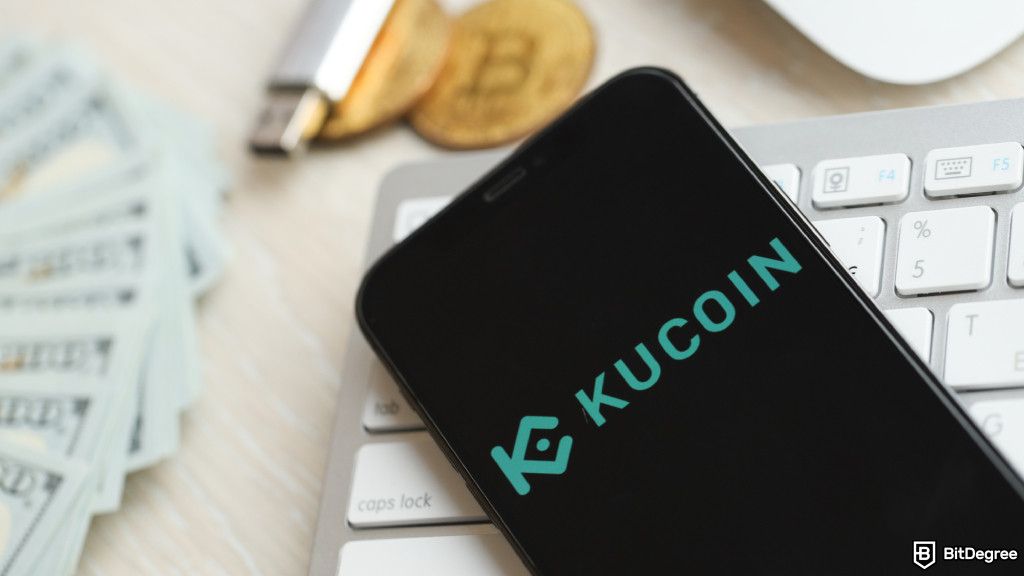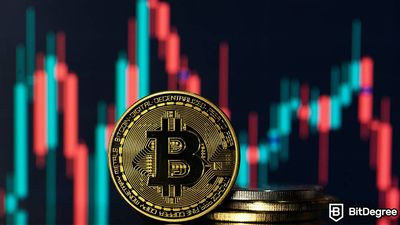Key Takeaways
- The KuCoin exchange platform typically doesn’t impose fees for depositing fiat or crypto, but some payment methods or specific coins might come with a small additional charge;
- KuCoin withdrawal fees for cryptocurrencies vary by coin and network, while euro withdrawals have a flat fee of 1 EUR, and pound withdrawals are either 5 GBP or 25 GBP, depending on the method;
- KuCoin trading fees follow a maker-taker structure and vary by trading categories, with regular spot fees set at 0.100%.
Stop overpaying - start transferring money with Ogvio. Join the waitlist & grab early Rewards NOW! 🎁
If you're new to crypto trading and looking for an exchange to get started—or a seasoned user exploring new options—there are high chances that you've already heard of KuCoin. Known for its wide selection of coins and user-friendly features, it's easy to understand why this platform is a popular choice. But before you try it out, it's a good idea to get a good grasp of the KuCoin fee structure.
Here, I’ll break down all the fees you might run into, like trading, withdrawal, and any hidden costs you should be aware of. Plus, I'll compare KuCoin fees with other top crypto exchanges, like Binance and Kraken, to help you make the best choice for your trading journey.
Note that these fees can change from time to time, so it’s a good idea to check its official website for the most up-to-date KuCoin fee schedule.

Did you know?
Subscribe - We publish new crypto explainer videos every week!
What Are Crypto Rollups? ZKSnarks vs Optimistic Rollups (ANIMATED)


Table of Contents
KuCoin Fees
If you’re here to dig deeper into KuCoin fees, you’ve probably heard about its popularity as a crypto exchange. Since its launch in 2017, KuCoin has made a strong impact in the crypto space, earning the trust of millions of users.
Latest Deal Active Right Now:With a community of over 27 million, the platform is well-regarded thanks to its intuitive design, advanced features, and an impressive selection of over 700 cryptocurrencies. This lineup includes popular coins like Bitcoin, Ethereum, Solana, Tether, and Dogecoin, plus plenty of niche altcoins.
KuCoin is accessible to users in many regions and supports more than 50 fiat currencies for easy crypto purchases. Plus, the platform also has a user-friendly mobile app, allowing you to manage and monitor your assets on the go.
On top of that, KuCoin offers diverse trading options, including spot, margin, futures, and P2P trading. That’s why understanding KuCoin fees is essential if you wish to explore these services effectively to grow your portfolio.

If you’re new to the space, it’s important to note that KuCoin, like most exchanges, requires identity verification (KYC) before you can make your first transaction. It typically involves submitting proof of identity and a personal photo. The whole process is usually quick, taking about 3 to 5 minutes, and it helps keep your account safe and secure.
With that in mind, let’s explore KuCoin fees across its various trading categories.
KuCoin Deposit Fees
To start, it's good to know that the platform generally doesn’t impose KuCoin deposit fees for depositing most cryptocurrencies. It means that you can add funds to your account without worrying about extra costs. However, there are some exceptions for specific tokens, like BEP-20 ETH and LUNC.
KuCoin also has a minimum deposit number for each crypto to help prevent issues like asset loss. If you're transferring from another platform, remember to factor in any withdrawal fees from that exchange to ensure your deposit meets KuCoin's minimum requirement, which is conveniently displayed during the transaction.

When it comes to traditional money, KuCoin fiat deposit fees can vary depending on how you choose to pay. For instance, if you deposit Russian rubles using a bank card, there's an additional charge of 3.10%.
On the other hand, if you use a SEPA bank transfer to deposit euros, there might be a fixed payment of around 1 EUR. It’s a good idea to review the available options and their specific KuCoin fiat deposit fees in advance to choose the best method for your needs.
KuCoin also has daily limits on fiat deposits. These limits reset at 0:00 UTC daily and are calculated in USD equivalents.
- Fiat deposits: $150,000;
- Crypto deposit using fiat: $50,000;
- Crypto deposit using a bank card: $100,000.
If you happen to make a deposit mistake and need assistance recovering your funds, KuCoin may charge a recovery fee. Here’s a quick summary of those charges for any incorrect deposits:
| Issues | Processing time | Fees (USDT) |
|---|---|---|
| Missing or incorrect memo | 2-3 days | 40 |
| Failed deposit due to missing or incorrect memo | 2-3 days | 80 |
| Deposit of unlisted tokens on supported networks | 2-3 days | 80 |
| Deposit of delisted tokens | 2-3 days | 80 |
| Deposit to a hot wallet | 2-3 days | 80 |
| Deposit to a deactivated account | 14 days | 80 |
| Deposit of unlisted tokens on unsupported EVM networks | 14 days | 200-500 |
Table: KuCoin recovery fee for incorrect deposits.
Note that due to resource limitations, technical complexities, and other factors, KuCoin doesn't guarantee a successful recovery for incorrect deposits. So, it’s always best to double-check all the details before confirming any transaction to avoid these situations altogether.
With all the details on KuCoin deposit fees covered, let’s move on to the withdrawal fees.
KuCoin Withdrawal Fees
Like most exchanges, KuCoin withdrawal fees for cryptocurrencies can vary depending on which specific coin you’re taking out and the network you choose. Usually, faster and more scalable networks offer lower prices, while popular but slower networks might have higher fees due to higher demand and limited capacity.[1]
Thankfully, KuCoin allows you to check the required fees directly on the withdrawal page, making it easy to review before proceeding. This way, you can conveniently choose from multiple network options and select the one that best suits your needs.

Here’s a quick tip: Avoid choosing a network solely because it has lower fees. Instead, pick a network that’s compatible with your crypto wallet to ensure your coins are safely transferred.
For fiat, KuCoin withdrawal fees also vary depending on the currency and the method you pick. As of writing, the platform only supports withdrawals in GBP and EUR. Here’s a simple overview of KuCoin transfer fees to a bank account:
For euro withdrawals:
- SEPA transfer: 1-2 business days, with a 1 EUR fee and minimum withdrawal amount of 5 EUR.
- SEPA Instant transfer: Nearly instant, with a 1 EUR fee and minimum withdrawal amount of 5 EUR.
For pound withdrawals:
- FPS transfer: Nearly instant, with a 1 GBP fee and minimum withdrawal amount of 5 GBP.
- CHAPS transfer: 1 business day, with a 25 GBP fee and minimum withdrawal amount of 50 GBP.
As a heads-up, KuCoin has daily withdrawal limits. For fiat currency, you can withdraw up to $150,000 per day. For crypto, limits range from 1 million to 60 million USDT equivalent, depending on your account verification status and VIP level.
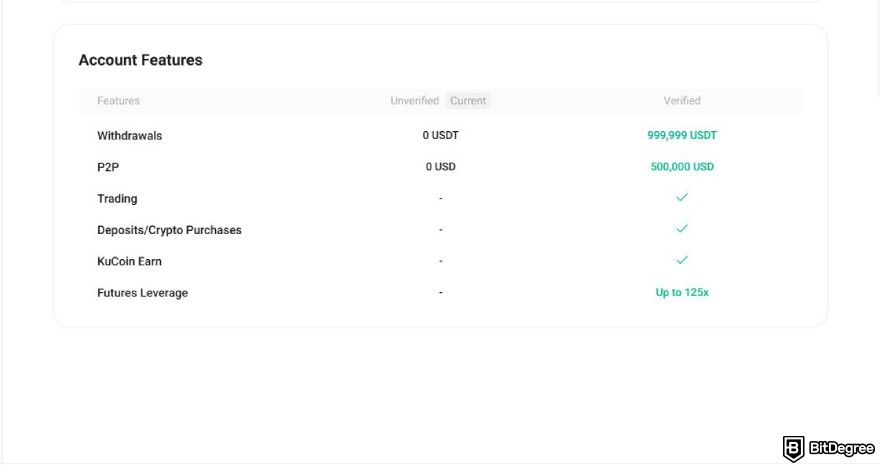
Understanding KuCoin withdrawal fees and daily limits is essential, especially if you’re a high-volume trader moving large amounts of holdings regularly. These factors can significantly impact your strategies and bottom line. Plus, there are also KuCoin trading fees to consider, which I’ll break down for you next!
KuCoin Trading Fees
In line with industry standards, KuCoin charges trading fees per executed trade, with rates varying across different categories. Key factors that impact your fees include your maker/taker status, VIP level, KCS holdings, and the trading pair you choose.
First, let’s look at KuCoin maker-taker fees. If you're a "maker", you usually pay a bit less because you add liquidity to the market by placing an order that doesn’t fill right away.
In contrast, if you’re a "taker", you typically pay a bit more in fees because you're taking away market liquidity by completing an order immediately.

Next, there's a VIP program that can significantly influence your KuCoin fees for buying crypto. This tier-based program rewards you for trading higher volumes by lowering costs as you become more active on the platform.
Each VIP level cuts down on KuCoin maker-taker fees and brings in extra perks to make managing your trading expenses easier. Basically, the more you trade, the more you save!
Also, if you hold the platform native coin, KCS, there are two ways it can impact your trading fees:
- Paying fees with KCS: You can choose to cover your trading fees using KCS, which gives you a nice discount;
- Holding KCS: If you keep accumulating KCS in your account, you can level up in the VIP program and enjoy even lower KuCoin maker-taker fees.
Additionally, the trading pair you pick can affect your fees, too. In most cases, KuCoin trading fees are deducted from the quoted currency pair (like USDT in BTC/USDT).
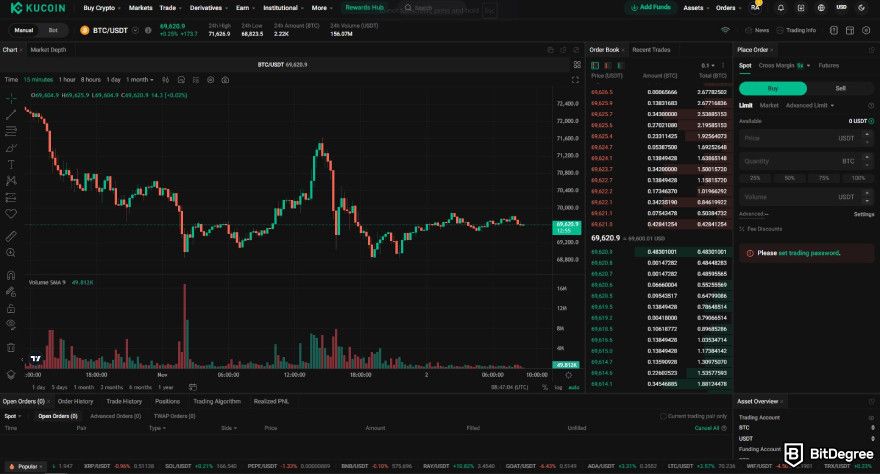
However, in some situations, KuCoin may deduct fees in the same coin being traded, which means the actual number received could be slightly less than expected.
If you're curious, there are even more tricks to help reduce these fees, but I'll cover this later in the article. For now, let’s focus on KuCoin trading fees by category!
Spot Trading Fees
If you're a regular user, KuCoin spot fees start at 0.1% for both makers and takers. However, if you’re trading higher volumes over a month or hold a decent amount of KCS tokens, you can start climbing the tiers and get some nice reductions.
For instance, as you move up to the next level, KuCoin fees for buying crypto are immediately reduced to 0.090%, though selling fees might remain the same as regular users.
At higher VIP tiers, though, you might even reach zero fees as a maker, and at the top level, you could earn small rebates for adding liquidity.

On top of that, you can save even more money by using KCS to pay for the transaction, which gives you up to a 20% discount on all KuCoin spot fees regardless of your VIP level.
Margin Trading Fees
KuCoin’s margin trading allows you to amplify trades by borrowing funds, with the option to choose between cross-margin and isolated margin modes. Here’s a quick breakdown of the margin fees KuCoin applies:
- Trading Fees: Margin trading fees are similar to standard KuCoin spot fees, which can vary based on your VIP level and whether you pay fees with KCS;
- Interest on Borrowed Funds: The interest rate is calculated hourly based on the principal amount, daily rate, and actual borrowing time. This interest is adjusted frequently, depending on market conditions, to reflect supply and demand;
- Service Fee: The platform charges a service fee of 5% of the interest income, with an additional 10% directed to a risk reserve fund.
While the margin fees KuCoin offers provide flexibility and potential for higher profits, they also come with greater risk. It’s essential to keep an eye on your debt ratio, as hitting 97% could trigger forced liquidation.
Futures Trading Fees
KuCoin futures fees differ slightly from regular spot trading, with standard fees set at 0.020% for makers and 0.060% for takers.
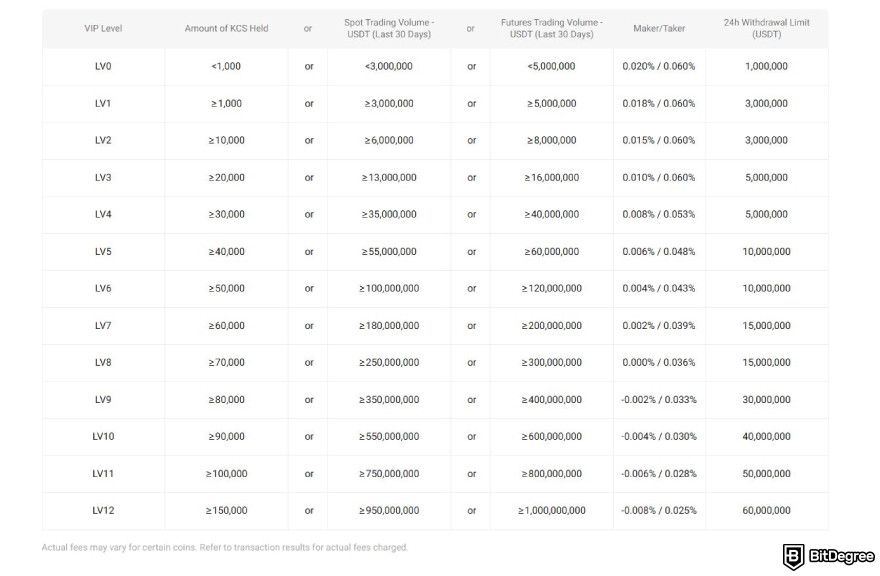
Just like in spot trading, though, as you trade more and hold onto more KCS tokens, you can climb up the VIP levels to enjoy lower fees. Once you hit VIP Level 8, your maker fees drop to 0%, and at Level 9, KuCoin rewards makers for adding liquidity.
One thing to keep in mind: you can’t use KCS for additional discounts on KuCoin futures fees. A bit of a downside, but overall, the costs remain competitive in the market.
Leveraged Trading Fees
KuCoin also offers leveraged trading, allowing you to potentially increase profits by trading certain assets with a 3x multiplier. This means that both gains and losses are amplified threefold.
For example, let’s say you’re trading Bitcoin. If the BTC price goes up by 1%, a special token that uses a 3x multiplier (BTC3L) will increase by 3%. On the flip side, if you have a token that goes against Bitcoin (BTC3S), it would drop by 3%.
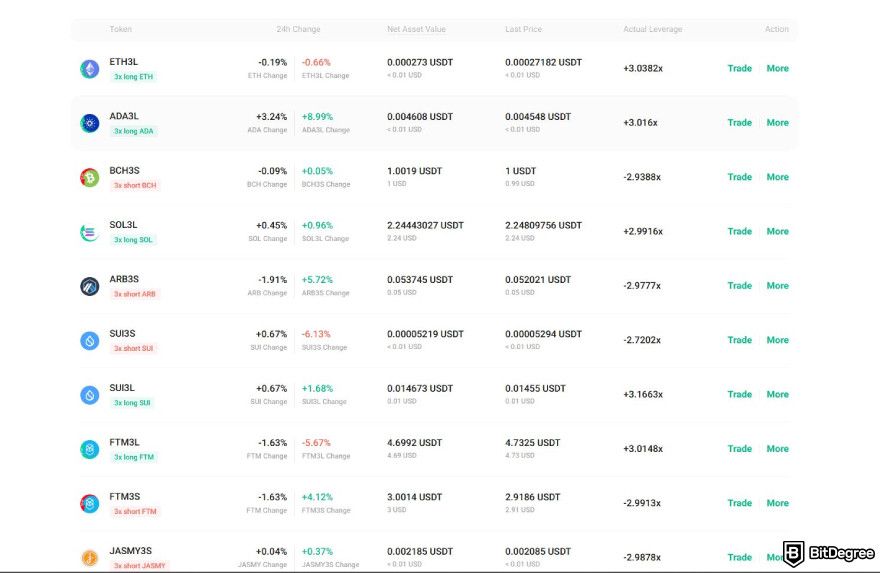
If you're thinking about giving leveraged trading a try, here are a few KuCoin fees you should keep in mind:
- Trading Fees: These are the same as KuCoin spot fees, so you'll pay the standard rate when buying or selling these leveraged tokens.
- Subscription Fee: This is 0.1% and is charged when you first subscribe to a leveraged token.
- Redemption Fee: Also at 0.1%, this fee is applied when you decide to redeem your leveraged tokens.
- Management Fee: This is 1% and is charged daily at 23:45 UTC. It automatically adjusts based on market conditions to reflect changes in market volatility.
While leveraged trading might sound appealing, it's important to remember that it's quite complicated and may not be suitable for beginners. Since both your potential profits and losses are amplified, even small changes in the market can lead to significant gains or losses.[2] So, if you decide to jump in, take your time to understand the risks and tread carefully!
Options Trading Fees
KuCoin options trading employs "European-style" contracts, meaning you can benefit from price changes in assets without the need for early trades or complex borrowing processes. This style lets you hold contracts until the expiration date, simplifying the experience and focusing on price movement.
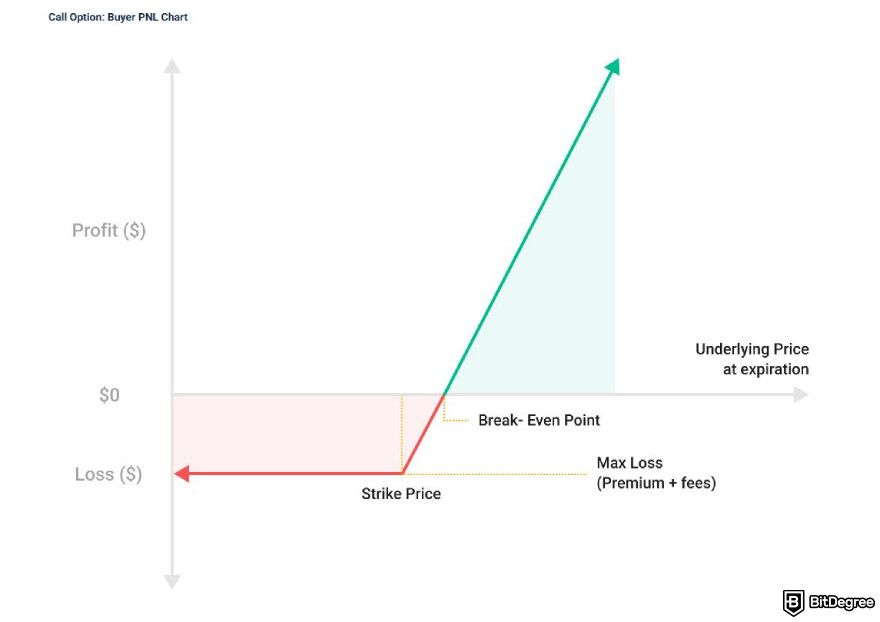
If you’re interested, here’s a breakdown of the fees you’ll encounter:
- Trading Fee: Each trade incurs a fee at a rate of 0.03%. This is calculated based on the index price of the underlying asset and is capped at 10% of the premium paid for the option;
- Exercise Fee: If you decide to use your option, you’ll pay a fee of 0.02%. It is calculated based on the price at which the asset settles when you exercise your option and is capped at 10% of your profit from the option.
While potentially rewarding, this type of trading requires a solid understanding of key concepts and strategies to navigate the market effectively. If you're just starting, checking out BitDegree's options trading guide can give you a strong foundation for a profitable and fulfilling journey!
Other KuCoin Fees
I’ve covered most of the fees you’re likely to encounter, but you might still be wondering if there are any additional costs—or perhaps even KuCoin hidden fees lurking somewhere. So, let’s take a closer look at other charges you might come across as you explore the platform’s full range of services.
Trading Bot Fees
KuCoin offers trading bot services that make it easy to automate your trades in both spot and futures markets. While using the bot itself is free, regular trading fees still apply based on the specific strategy and market.
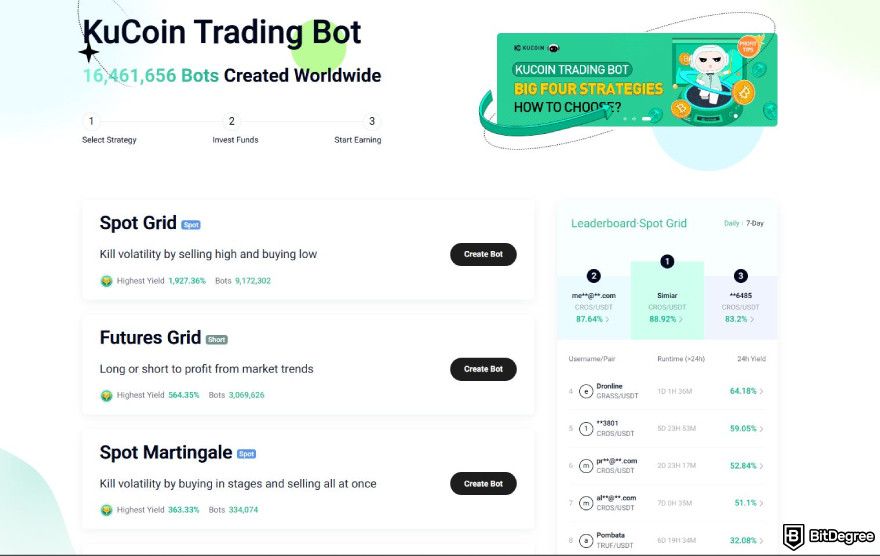
For spot trading, if you use the bot and pay your fees in KCS, you can get a 20% discount on the regular KuCoin maker-taker fees, making it a pretty appealing option. The bot supports several trading strategies, such as Spot Grid, Infinity Grid, and DCA, among others.
KuCoin futures fees are also pretty straightforward, with taker fees set at 0.06%, making it easy to calculate costs for any futures strategies you plan to automate.
KuCard Fees
KuCard is a crypto debit card that makes it easy to spend your digital assets for everyday purchases. If you’re thinking about getting one, here’s a quick breakdown of the fees you might encounter:
- Application Fees: The first virtual card is free for VIP 0 and VIP 1 users. Additional virtual cards are priced at 9.99 EUR each. Physical cards cost 9.99 EUR for the first card and 19.99 EUR for each additional one;
- Transaction Fees: Domestic EUR transactions are free, while international transactions in non-EUR currencies carry a 2% fee. ATM withdrawals within Europe cost 2 EUR, with international ATM withdrawals adding 2 EUR plus 2% of the amount withdrawn;
- Other Fees: There’s a 10 EUR annual fee, waived if you spend over 500 EUR annually. Inactivity fees of 3 EUR apply after 90 days of no use, and express delivery for physical cards is available for 30 EUR.
Note that some ATMs may charge extra, especially for currency conversions. So, if you're using KuCard, be sure to check the ATM's instructions carefully to avoid any surprises—these fees are from the ATM provider, not KuCoin.
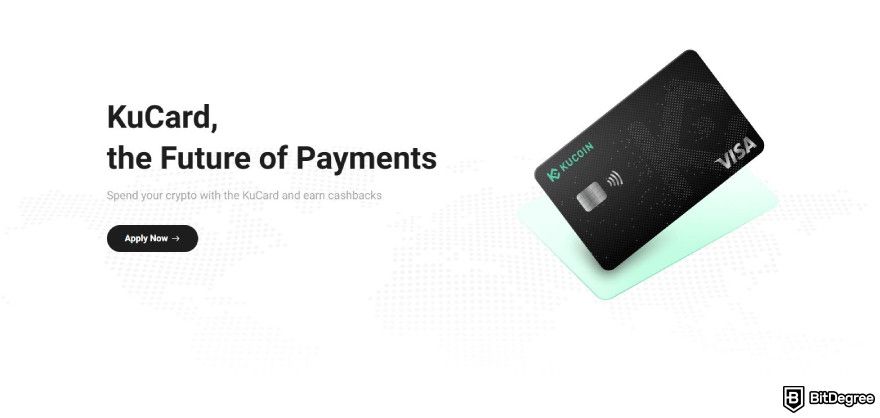
KuCoin "Hidden" Fees
Now, you might be curious if there are any KuCoin hidden fees to watch out for. After a thorough look, I can say that the exchange is fairly transparent about its fee structure, and there shouldn’t be any unexpected surprises.
That said, some fees might catch you off guard, especially if you’re new to crypto trading. Here’s a rundown of these “hidden” costs that may seem unexpected but are pretty standard across most exchanges:
- Network Fees: Transferring funds from KuCoin to an external wallet requires blockchain-set fees, often called "network" or "gas" fees. These vary by network and are not imposed by the platform. So, referring to them as "KuCoin network fees" or "gas fees KuCoin charged" isn't accurate;
- Trading Fees in Different Tokens: KuCoin usually charges trading fees in the quoted currency or sometimes in the traded token. This might seem unexpected, but it’s just how KuCoin fees are calculated;
- Conversion Fees for Fiat-to-Crypto Transactions: When buying crypto with fiat through KuCoin’s partners, such as Simplex or Banxa, additional transfer fees or a spread in the final price may apply. Third parties set these fees and can feel like hidden costs if they’re not clearly shown upfront.
So, if you encounter unexpected fees when using the platform, chances are they’re set by external parties, not KuCoin itself. I hope this simple overview clears up any confusion!
KuCoin Fees Comparison
With a clearer picture of the KuCoin fee structure, you might be curious about how it stacks up against other popular platforms. Understanding these differences can help you figure out if KuCoin fees are right for your trading strategies and budget.
In this comparison, I’ll look at KuCoin trading, deposit, and withdrawal fees alongside those of two other well-known platforms: Binance and Kraken.

Did you know?
Subscribe - We publish new crypto explainer videos every week!
What Are Flash Loans? TOP Ways to Make Passive Income Explained


KuCoin Fees VS Binance Fees
Without a doubt, Binance is among the top exchanges out there thanks to its advanced features, accessibility, high liquidity, and large user base. When it comes to fees, you’ll find that Binance and KuCoin have a lot in common.
First, both platforms have a tiered fee structure that rewards you with lower fees if you trade more often or in higher volumes. Plus, Binance also has its own native tokens—BNB—that you can use to help move up the VIP tiers or cut down on trading fees.
But there's a key difference in how their VIP levels work. KuCoin lets you qualify for a VIP tier by either holding a specific number of KCS or by hitting a certain trading volume in a month.
On the flip side, Binance requires you to meet both criteria to move up a tier. For instance, to get to VIP 1 on Binance, you need at least $1,000,000 in trading volume and a set number of 25 BNB.
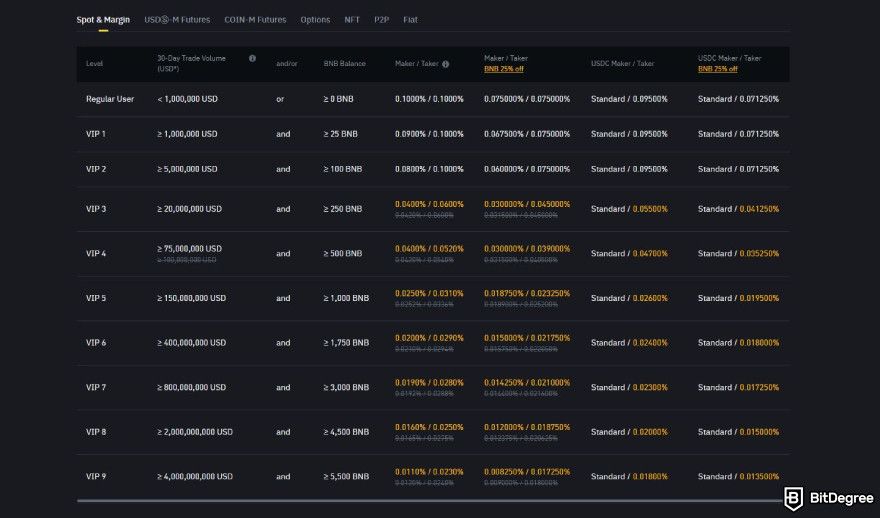
Binance's VIP programs also have a steeper climb. The top tier on Binance requires a massive $4 billion in trading volume, while KuCoin’s highest level needs just $950 million.
At the highest tiers, Binance offers impressively low spot trading fees at 0.00825% for makers and 0.01725% for takers, while KuCoin maker-taker fees at the top can go as low as -0.005% and 0.020%.
If you’re just trading casually and not looking to climb up, both exchanges start their spot trading fees at 0.1%. For futures trading, Binance kicks off with fees of 0.02% for makers and 0.05% for takers.
Both platforms let you deposit crypto for free, but the withdrawal fees change based on the type of crypto and network you choose. Fiat deposits and withdrawals also fluctuate depending on how you want to pay.
All in all, both exchanges offer competitive rates and solid discounts through their native tokens. While Binance is popular for its accessibility and higher liquidity, KuCoin fees hold their own—especially with potentially lower costs for high-volume traders looking to move up the VIP tiers.

- Secure and reliable
- Accepts fiat currencies
- Lots of trading options
- Reputable exchange
- Accepts fiat currencies
- Offers various trading options

- Huge trading variety
- Regulation-compliant around the globe
- Fair trading fees
- Beginner-friendly
- A wide array of features
- Vast number of different crypto coins & tokens

- Beginner-friendly
- Secure
- Decent trading and withdrawal fees
- Crypto.com Visa Card
- Automated tools & bots
- Ecosystem synergy with CRO
KuCoin Fees VS Kraken Fees
Kraken is a reputable cryptocurrency exchange in the world, known for its strong focus on security and user-friendly features.
Like KuCoin, Kraken also has a tier system that allows you to pay lower fees as you trade more. However, Kraken doesn’t have its own native token. So, to qualify for lower trading fees, you only need to reach a certain amount of trading activity each month.
When it comes to trading, Kraken has a lower requirement for advancing to a higher fee tier. You only need to trade $10,000 to reach the first level, while KuCoin requires $3,000,000.
At the highest levels, Kraken's fees can go as low as 0.00% for makers and 0.10% for takers. For futures trading, the costs can even drop into the negatives for makers, earning you rebates.
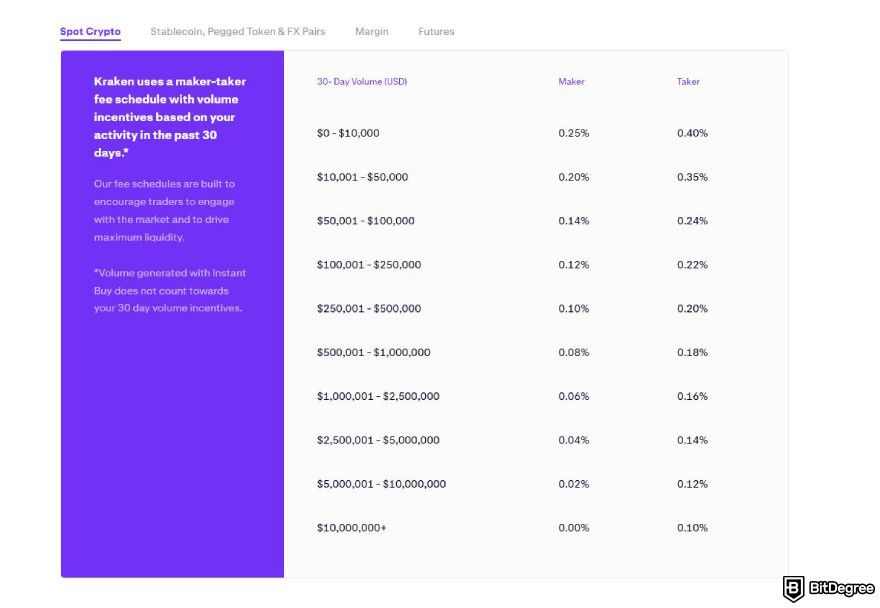
For average users, though, Kraken spot trading fees start slightly higher, with 0.25% for makers and 0.40% for takers. Its futures trading fees, however, are more in line with KuCoin, at 0.020% for makers and 0.050% for takers.
When you want to deposit or withdraw assets from Kraken, be aware that fees can vary depending on the currency and the method.
In short, if you’re starting out in crypto or only trade now and then, you might find KuCoin fees attractive. But if you’re someone who trades a lot, Kraken could be a better option since it offers significantly lower fees the more you trade.
How to Avoid KuCoin Fees? Useful Tips
Here’s the bad news: if you want to know how to avoid KuCoin fees entirely, I’m afraid I can’t help you with that—there’s no way to do it without bending the rules (and that’s never a good idea). That said, I do have a few handy strategies to help you reduce those extra charges and get more value out of your trades on the platform.
Tip 1: Climb the KuCoin Fee Tiers
While it’s not the easiest option for everyone, one of the most effective ways to reduce KuCoin fees is by advancing through the VIP levels. As mentioned earlier, the KuCoin fee structure rewards active traders with progressively lower costs as they trade more or hold additional KCS.

At the start, KuCoin fees are pretty standard, but as you climb the levels, you’ll start to enjoy some nice discounts.
For example, once you reach the fifth tier, your maker fees drop to 0%. And if you reach the highest levels, KuCoin will even pay you for providing liquidity.
So, if you trade regularly, reaching those higher VIP tiers can really help you keep more of your hard-earned profits.
Tip 2: Pay with KCS to Cut Fees
Another easy way to reduce your KuCoin trading fees is by using the platform's native token for payment. Enabling this option grants up to a 20% discount on KuCoin maker-taker fees, which can add up to significant savings over time, especially for frequent traders.
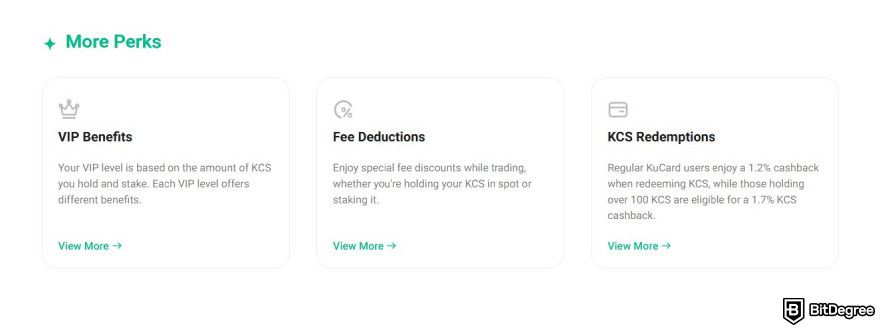
To set this up, follow these simple steps:
Step 1: Click on your profile picture at the top-right corner of the KuCoin website to open your user settings.
Step 2: In your profile settings, look for the option to [Pay fees with KCS] and switch it on.
Step 3: On the trading page, make sure the [Fee Discounts] option in the top-right corner is enabled.
Once you’ve enabled this option, KuCoin will automatically use KCS to cover your trading fees. Just make sure you keep enough KCS in your balance; if you don’t have enough, the discount won’t apply.
Tip 3: Take Advantage of Coupons and Promotions
KuCoin Rewards Hub is packed with limited-time offers and exclusive bonuses that can help you save on trading fees and even boost your funds. As you complete tasks—like making your first trade or deposit—you unlock rewards. The prizes include USDT or trading coupons to lower KuCoin fees for buying crypto and maximize your trades.
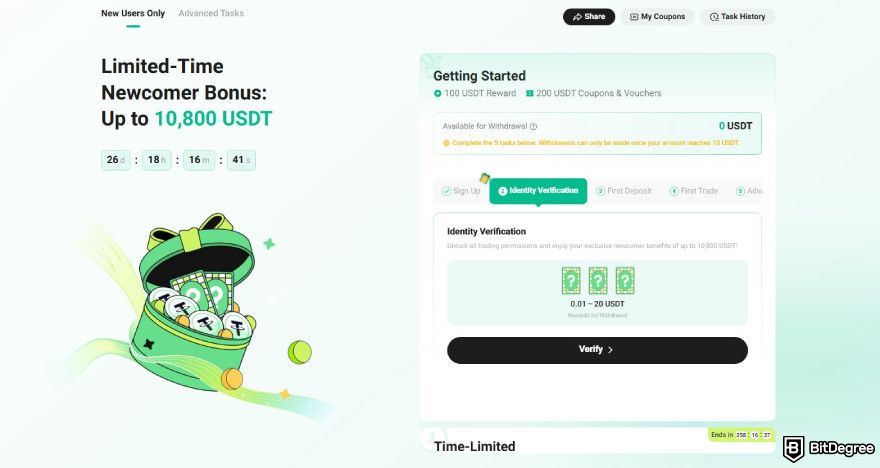
Additionally, KuCoin also regularly rolls out high-yield promotions and exclusive coupons based on deposit volumes and trading milestones. You’ll also find limited-time bonuses tied to P2P trades, third-party purchases, and more.
Keeping an eye on these offers lets you save on Kucoin transfer fees while exploring the platform's rich features at a discount. To stay in the loop, check KuCoin’s Rewards Hub regularly or follow them on social media for the latest promotions. With the right timing, these prizes and fee-reduction coupons can make a big difference—especially if you’re trading a lot.
Tip 4: Consider Signing Up for the Kucoin Affiliate Program
KuCoin Affiliate Program is another appealing way to offset your trading fees, and it’s especially handy if you’re active in crypto communities or have a network of friends interested in trading.
By signing up as an affiliate, you get a unique referral link to share, and every time someone signs up and trades through that URL, you can receive a commission—up to 60% of their trading fees.

What’s even better is that the program has a second-tier commission system. This means if your friends become affiliates themselves and refer others, you can earn a portion of those fees, too.
Over time, these earnings can really add up, helping you cover your trading costs and maybe even giving you a nice little bonus. Plus, the KuCoin affiliate feature has a simple, easy-to-navigate dashboard where you can easily keep track of your referrals and how much you’re earning.
While there’s no foolproof way to avoid KuCoin fees entirely, I hope those tips can help you minimize them and keep more of your gains. By climbing the VIP ladder, using KCS for fee discounts, taking advantage of promotions, and sharing your referral link, you’ll be able to save more on fees—leaving you with extra funds to grow your portfolio!
Conclusions
To wrap it up, KuCoin fees are among the more competitively priced in the crypto market, allowing it to hold its own against major exchanges like Kraken and Binance.
For new or casual traders, KuCoin's entry-level fees are affordable and consistent with industry standards, making them easy to manage. For those trading more frequently, its VIP tier system can offer significant savings as you progress through the level.
As your gains accumulate and your portfolio grows, consider moving holdings you don’t plan to trade to a secure hardware wallet like Ledger Nano X or Trezor Safe 5. This way, you can trade with peace of mind, knowing your assets are safely stored offline!
The content published on this website is not aimed to give any kind of financial, investment, trading, or any other form of advice. BitDegree.org does not endorse or suggest you to buy, sell or hold any kind of cryptocurrency. Before making financial investment decisions, do consult your financial advisor.
Scientific References
1. G. Shang, N. Ilk, S. Fan: 'Need for speed, but how much does it cost? Unpacking the fee-speed relationship in Bitcoin transactions';
2. P. Mueller: 'Defi leveraged trading: Inequitable costs of decentralization'.
